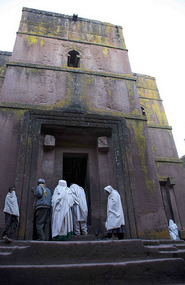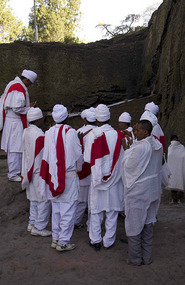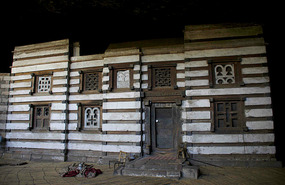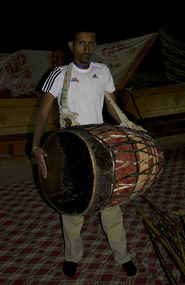I had a deep sleep in Gonder after the trek, but the scramble to leave the hotel for the bus station woke me up at 4.00am again and it was difficult to sleep afterwards. It was nice though to get back on the internet and I lazed in bed reading the news.
Finally I got up and walked past the scruffy Plaza to a new restaurant I had passed in the bus, that looked inviting
. I could not understand the menu or the staff so just pointed like I used to in China. As I was the only one there, I no idea what to expect. It turned out to be a real treat. The “Full” breakfast was one egg scrambled on hot chill bean and tomato paste with fresh natural yoghurt and fresh bread. Delicious and freshly ground coffee to match - heaven.
I plumped for a day off after yesterday’s exertions and wanted to sort out some things on the internet. I got my kit washed, sorted out my flights to Madagascar and was generally organised. Then, at the recommendation of Lonely Planet (taking a risk - I know), took a Bajaj (an auto rickshaw) to the Debra Behan Selassie Church. After the impressive bath house i felt I should not miss another historical site in this old capital.
This church again did not disappoint. Flush with a tour group, it was built in the 17th century and is an unusual two tiered thatched roofed church in great condition
. The whole church is enclosed by a high (intact) stone wall with 12 towers. The entrance gate symbolised Jesus and had a watermark of a cherub on it, that locals say ‘appeared one morning”. If that was not enough, its the interior of this church that is special. The part of this orthodox church that non-believers are allowed into contained beautiful frescos depicting the bible, the life of St George and one of Mohammed. But its the ceiling that amazes with 130 odd angel faces starring down at you, each in remarkable condition. This priest volunteered to take me around showing me his drums and explaining the frescos. Great.
Another morning and a four o'clock start. I was glad to leave the L-Shape, it was noisy and the only tourists were Israelis who kept to themselves - as usual. The bus station was recognisable chaos again and despite the hotel manager insisting there a minibus to Gashena, no broker appeared to confirm this, so I joined the local bus (luckily in the front seat) and fell asleep. I was awoken by what turned out to be our first mechanical breakdown of the morning and took that opportunity to have “a pee break”. Whilst most of the woman scurried around the bus looking for bushes the men crowded in over the engine - “ah repair by consensus” I thought.
Two further stops ensured we arrived several hours late in Gashena, at which point I could see my connecting bus for Lalibela leaving in the distance
. This was a huge blow as I only had one full day in Lalibela to see the UNESCO Rock-Hewn Churches and I needed to get an entrance ticket the day before (the ticket office shut in 2 hours time). Faced with an expensive option of chartering a minibus or sleeping in dusty Gashena and maybe missing Lalibela, I opted for the former. But as with all minibus business this was destined to go wrong.
I decided to take the “cool and detached” approach and walked to cafe opposite the minibus stand and sure enough just as my coffee arrived, so did a broker. He was quite young and looked like what my friend Maddie would call a “Gigimushi”. A long protracted negotiation occurred in which I increased price 400 Br and he dropped 50. I should have have realised then that this was a bad idea.
Eventually we agreed on a hefty 25$ and I loaded up the gear. He then drove off to a group of locals and started picking them up, in order “to balance the bus over the dangerous road!” he said. I was bemused but then as the other broker started to asking the locals for additional fees my temper exploded. I was furious that he was charging the locals, as I was paying on this agreed contract for a charter. I had no problem with him giving the locals lifts, but not to make extra money. As tempers flared I pulled off my luggage and started walking back to the main crossroads followed by yelling brokers and confused locals
.
We must have looked an odd sight to two Dutch men who just arrived at the crossroads, but luckily with their help we renegotiated the charter (although I still ended up paying in excess of 15$) and free transport for two monks.
The two hour journey over the rough stone strewn road was uncomfortable and made worse by the driver who kept looking at me smiling and saying “peace Bro”. I was pleased when we arrived at the mountain top city of Lalibela (2800m) and dropped the dutch off at their guesthouse. I finally managed to insist on being taken to the guesthouse of my choosing, but not without loosing my temper again. “Peace Bro”.
Salam Guesthouse was an oasis of quiet. A family run guesthouse away from the bustle, noise and dust of the city centre, but not away from the clutches of the hustlers
. Salam and her family were quick to settle me in and then help me with directions to the ticket office. I had to run their before they closed, not something I usually do especially this altitude, so you can imagine my disgust when I hear the words “peace bro” only to find the minibus broker following me. I managed to get the security guard to bar his access to the ticket office as arrived with four mins left, only to meet another apparent hustler inside. I was too exhausted to get angry again so I let him process my ticket with the site official. I was just about to steel myself for another argument when he produced an official pass and told me that this “ticket acquiring service “ was for free and he was an official guide whom I could use tomorrow if i wanted. He said his name was Addisalam. I was quite surprised at this “free service” so I took his phone number and left, only to be confronted by the original broker outside. This time the commotion was solved when Addisalam (whom I will call Addis) told him to buzz off. Later that evening after a great Ethiopian meal, I phoned up Addis and agreed to use him.
We started off as I had hoped at 6.00am in the pitch black at St Georges, one of the 11 Rock Hewn Churches of Lalibela and considered the ‘masterpiece’. King Lalibela dug & built all these churches in 12th century over (as legend has it) a 23 period. His goal inspired by a meeting with God was to bring Jerusalem to his subjects. This extraordinary task was completed (locals believe) with celestial assistance and once you have visited the churches, you can understand the fervour of their beliefs.
St Georges at daybreak was magical. Everything I had anticipated, yet even more magical as the priests started their Saturday morning chanting and pilgrims gathered. Surprisingly and luckily I was the only tourist and together with Addis, was allowed complete access to the whole amazing site, except the inside of the church during the service.
Wafts of incense consumed the narrow rock carved walkaways opening up onto the three story church ascending some 15m out of the rock towards the sky. With its unique distinctive cross flat roof and 12th century guttering it was a magical experience. The pilgrims all shuffled past in their white Cortas, offering me just a sneaky glance and then they prostrated themselves in front of St Georges. Addis showed me the Hermit caves that surround the church, plus the ancient flour mills and bread ovens carved into the solid rock walls. Finally we saw the mummies of the first priests all resting in another cave opposite the entrance.
At 9 o’clock we called it quits as the first tour group arrived and headed back to the town centre for breakfast, on the way stumbling on a wedding ritual in front of another rock hewn church. We returned to what is termed the northern rock cluster in the late morning and started to view these five churches. Built just a few years before St Georges two were large and three others were small and not in such good condition. UNESCO had built protective steel umbrellas over all these, which subdued their ambience somewhat compared with St Georges. However what makes them really special is the artwork and carvings within.
Each one was carved from the inside out and it was meticulously prepared, with every art work and window planned. Crosses and symbols abound inside ranging from Maltese Crosses to stars of David inspiring many theories about the architectural inspiration. Each roof was carved and many pillars had angels eyes in the eves. Many of the churches were two tiered containing galleries and carvings. The artwork was impressive, intricate and in a remarkable state of preservation. The two little churches at the end contained the bodies of the priest kings and other sensitive religious relics. Each church and its tunnels were dug by hand using small tools creating a spectacle which was awe-inspiring and one of the most impressive religious sites I have ever seen. Of course it also has the advantage of still being in use.
After lunch I wandered around the large Lalibela market in the hot sun whilst Addis sorted out the car and in the afternoon we set off north driving for 60mins on dirt roads until we could go no further. We then abandoned the car and walked the final hour up to 3000m to see the Monastery of Yemrehanna Kristos. This monastery of St Mary predates by nearly 100 years the churches of Lalibela, but was responsible for inspiring some of King Lalibela’s architectural ideas. However unlike the rock excavated churches I had seen in the morning this was built in a cave overlooking a small village in virgin wood (most of the Ethiopian trees of this area had long been felled).
Made of wood and stone with gypsum the two tone colouring was outstanding and the two buildings, one a church an the other a palace were beautiful. The cave was special in its own right looking as if it had been dug by hand, however it was in fact all natural. Behind the church at the back of the cave was the tomb of the man who established the site and then behind that was the monks chanting area. Right at the back of the cave was the mummified remains of the original monks.
Inside the cave church was the exquisite work of monks with the same array of crosses and symbols as I had seen in the morning, with intricate carvings and frescos. The wood carvings were exceptionally impressive and again in great condition. The priest showed us around and showed me his robes.
After a leisurely ride down the mountain we stopped in at another rock hewn church (another dedicated to St George), although Addis referred to it as a semi monolithic church, as it was not totally freed from the surrounding rock. Here the art was less inspiring but considering it was built over 400 years earlier than the others this was not surprising. The church contained some amazing old books, with stories of the saints written in Amharic on goat skin and bound in wood. The priest showed these to me as he did the four bee hives built high up into the side of the church wall. “Holy honey” he said.
It was a special day and Addis had been an exceptional guide. We had covered the best sites, but not everything as Lalibela really requires longer, but I had to leave again the next day to meet up with my trip to the Danakill Depression starting from the northern city of Mekele.
Addis kindness did not stop with the tour though and within hours, he had organised a lift back to Gashena leaving at 3.30am and a rendezvous with a minibus bound for Woldia at 5.45am. There he arranged his brother to meet me at the bus station and put me on a minibus bound for Alamata (after breakfast) where I would catch another minibus to Mekele. He estimated this would take some 12-14 hours and have me there in Mekele before nightfall.
Everything worked like clockwork and was quite painless. Wondatir, Addis’s brother was a character and treated me to breakfast when I arrived in Woldia. Now thats the way to travel by bus in Ethiopia!
Churches, Caves, Rocks, Pilgrims plus Minibuses
Sunday, February 16, 2014
 Lalibela, Amhara, Ethiopia
Lalibela, Amhara, Ethiopia
Other Entries
-
23National Parks, Road Rage, Drunks & a Tiger!
Oct 12127 days prior Bharatpur, Indiaphoto_camera4videocam 0comment 2
Bharatpur, Indiaphoto_camera4videocam 0comment 2 -
24Mosques, Cremations, Festivals & Dhal
Oct 21118 days prior Varanasi, Indiaphoto_camera7videocam 0comment 0
Varanasi, Indiaphoto_camera7videocam 0comment 0 -
25Nepal, trekking, Cold, Everest and Gurkas
Oct 28111 days prior Kayakatta, Nepalphoto_camera4videocam 0comment 0
Kayakatta, Nepalphoto_camera4videocam 0comment 0 -
26Karmi Farm, Sherpa Tenzing, Mr Happy and Momos
Nov 05103 days prior Darjeeling, Indiaphoto_camera4videocam 0comment 0
Darjeeling, Indiaphoto_camera4videocam 0comment 0 -
27Rhinos, Armed Guards & Posing For Photos
Nov 1494 days prior Kaziranga National Park, Indiaphoto_camera5videocam 0comment 0
Kaziranga National Park, Indiaphoto_camera5videocam 0comment 0 -
28Spiders, The Kharsi, Archery and Bad Driving
Nov 2088 days prior Cherrapunji, Indiaphoto_camera5videocam 0comment 0
Cherrapunji, Indiaphoto_camera5videocam 0comment 0 -
29Monpas, Sumo, Yak Butter Tea & Indian Army
Nov 2484 days prior Tawang, Indiaphoto_camera7videocam 0comment 0
Tawang, Indiaphoto_camera7videocam 0comment 0 -
30Uncles, Nuns, Bridges, Red Rice and Gompas
Nov 2781 days prior Sakti, Indiaphoto_camera5videocam 0comment 0
Sakti, Indiaphoto_camera5videocam 0comment 0 -
31Buddhist Festival, Feral Dogs, Exploding Cakes
Dec 0177 days prior Bomdila, Indiaphoto_camera6videocam 0comment 0
Bomdila, Indiaphoto_camera6videocam 0comment 0 -
32A Horror Journey
Dec 0375 days prior Tezpur, Indiaphoto_camera4videocam 0comment 0
Tezpur, Indiaphoto_camera4videocam 0comment 0 -
33Hornbill Festival, Nagas & Nagaland
Dec 1068 days prior Kohima, Indiaphoto_camera6videocam 0comment 3
Kohima, Indiaphoto_camera6videocam 0comment 3 -
34Pied Pipers, Hard Beds, Ao and Chang tribes
Dec 1860 days prior Mokokchung, Indiaphoto_camera7videocam 0comment 0
Mokokchung, Indiaphoto_camera7videocam 0comment 0 -
35Battles, Monoliths, Street Photography, Home
Jan 0146 days prior Dubai, United Arab Emiratesphoto_camera6videocam 0comment 0
Dubai, United Arab Emiratesphoto_camera6videocam 0comment 0 -
36Athens, Bristol, Doctors and Rain - lots of rain
Jan 1532 days prior Athens, Greecephoto_camera2videocam 0comment 0
Athens, Greecephoto_camera2videocam 0comment 0 -
37Addis, Bus Travel, Malibu Storks and Lake Storms.
Feb 0115 days prior Addis Ababa, Ethiopiaphoto_camera4videocam 0comment 0
Addis Ababa, Ethiopiaphoto_camera4videocam 0comment 0 -
38Minibuses, Police, Impounding, Gon
Feb 0511 days prior Awasa, Ethiopiaphoto_camera4videocam 0comment 0
Awasa, Ethiopiaphoto_camera4videocam 0comment 0 -
39Baboons, Mountains, 4000m Trek, Ibex
Feb 097 days prior Gonder, Ethiopiaphoto_camera5videocam 0comment 2
Gonder, Ethiopiaphoto_camera5videocam 0comment 2 -
40Churches, Caves, Rocks, Pilgrims plus Minibuses
Feb 16 Lalibela, Ethiopiaphoto_camera5videocam 0comment 0
Lalibela, Ethiopiaphoto_camera5videocam 0comment 0 -
41Volcanos, lava, sulphur & aggressive tourists.
Feb 215 days later Mekele, Ethiopiaphoto_camera4videocam 0comment 2
Mekele, Ethiopiaphoto_camera4videocam 0comment 2 -
42Rock Hewn Churches, Plan Changes, Addis
Mar 0113 days later Wukro, Ethiopiaphoto_camera3videocam 0comment 1
Wukro, Ethiopiaphoto_camera3videocam 0comment 1 -
43Lip Plates, Mursi, Mingi Children & Bad 4x4s
Mar 0517 days later Jinka, Ethiopiaphoto_camera4videocam 0comment 0
Jinka, Ethiopiaphoto_camera4videocam 0comment 0 -
44Hamar, markets, clothes and free beer (not for me)
Mar 0820 days later Turmi, Ethiopiaphoto_camera4videocam 0comment 0
Turmi, Ethiopiaphoto_camera4videocam 0comment 0 -
45Bull Jumping, Whipping, Wiggly Canoes, Addis Rain
Mar 1729 days later Johannesburg, South Africaphoto_camera6videocam 0comment 4
Johannesburg, South Africaphoto_camera6videocam 0comment 4 -
46Family, Food, the Cape and Animals
Apr 0144 days later Fish Hoek, South Africaphoto_camera4videocam 0comment 0
Fish Hoek, South Africaphoto_camera4videocam 0comment 0 -
47Baguettes, Renault 4s and a little bit of France
Apr 0952 days later Antananarivo, Madagascarphoto_camera2videocam 0comment 0
Antananarivo, Madagascarphoto_camera2videocam 0comment 0 -
48Indri, Chameleons, Weevils, Frogs and Night Safari
Apr 1255 days later Andasibe, Madagascarphoto_camera6videocam 0comment 0
Andasibe, Madagascarphoto_camera6videocam 0comment 0 -
49Air Mad, Rain, Leeches, Trekking, Jungles
Apr 1861 days later Sambava, Madagascarphoto_camera6videocam 0comment 0
Sambava, Madagascarphoto_camera6videocam 0comment 0 -
50Sifakas, Pygmy Kingfishers, Maroujejy NP Part 2
Apr 2164 days later Manantenina, Madagascarphoto_camera6videocam 0comment 0
Manantenina, Madagascarphoto_camera6videocam 0comment 0 -
51Cream sauces, paradise, sandy beaches, wildlife
Apr 2770 days later Diego Suarez, Madagascarphoto_camera5videocam 0comment 0
Diego Suarez, Madagascarphoto_camera5videocam 0comment 0 -
52Tsingy Rouge, Lemurs, Corruption, Air Madagascar
May 0174 days later Joffreville, Madagascarphoto_camera5videocam 0comment 0
Joffreville, Madagascarphoto_camera5videocam 0comment 0 -
53Glamping, Nat Parks, Dew, Blood & Gooners
May 2295 days later Swellendam, South Africaphoto_camera5videocam 0comment 0
Swellendam, South Africaphoto_camera5videocam 0comment 0 -
54Big Holes, Shut Attractions, Bush, Endless Roads
May 30103 days later Kimberley, South Africaphoto_camera4videocam 0comment 0
Kimberley, South Africaphoto_camera4videocam 0comment 0 -
55Fires, Towing and the Kindness of Strangers
Jun 01105 days later Gaborone, Botswanaphoto_camera1videocam 0comment 0
Gaborone, Botswanaphoto_camera1videocam 0comment 0 -
56Auto Parts, Nata Birds, Wind and Elephants
Jun 06110 days later Francistown, Botswanaphoto_camera3videocam 0comment 0
Francistown, Botswanaphoto_camera3videocam 0comment 0 -
57Water, Rivers, Camping, Customs and Getting Wet
Jun 10114 days later Victoria Falls, Zimbabwephoto_camera5videocam 0comment 0
Victoria Falls, Zimbabwephoto_camera5videocam 0comment 0 -
58Sand, Hides, Elephants, Birding, getting Stuck
Jun 15119 days later Kasane, Botswanaphoto_camera7videocam 0comment 0
Kasane, Botswanaphoto_camera7videocam 0comment 0

 Lalibela, Amhara, Ethiopia
Lalibela, Amhara, Ethiopia













2025-05-22